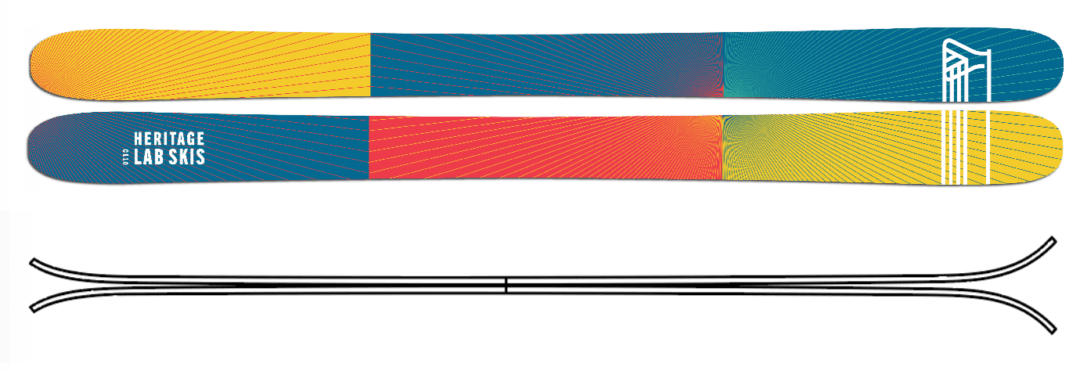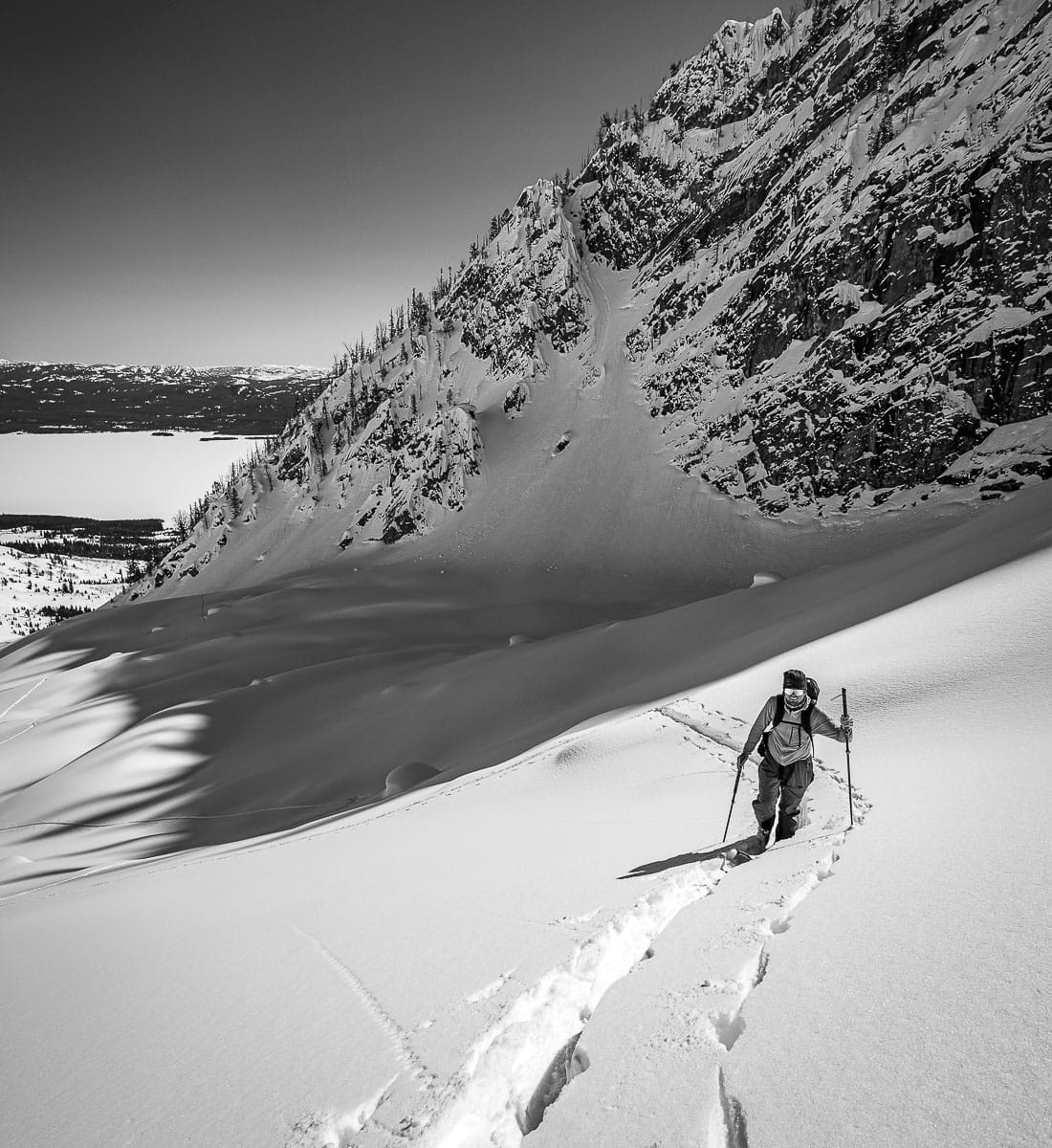Heritage Labs is a boutique ski crafter, that in their owns words,
“aims to fill this gap and is dedicated to offering special skis for performance skiers.” We took a round trip ride on their BC110, reverse camber backcountry planks.

Intro
We have written a fair bit about Heritage Labs at this point, and they continue to be one of the more exciting new brands on the market – especially for those of us indoctrinated into the world of reverse camber touring skis. While Heritage Lab began a few seasons ago with the mission of “bringing back” specialty ski designs of the past (which is certainlyhappening with models like the HB122), they continue to innovate and bring new and unique models to the touring market. The BC110 initially caught my eye as a 4FRNT Hoji-esque shape, but coming in about 250g lighter and at a Goldilocks (for me) length of 186cm. Given my love for the Hoji, I was smitten with the BC110 and was thrilled that Marshal (founder of Heritage Lab) was willing to let me test a pair for most of last winter.

Design Highlights
For what seems to be a growing contingent of ski tourists, reverse camber skis are catching on as “la verdad” for most wild snow conditions. Their performance in conditions from full powder to breakable crusts is generally both excellent and predictable, as well as the quick pivoting and maneuverability offered by their lack of a “wheelbase” that makes tight spots much easier to manage. Pairing these attributes with more neutral to progressive mount points allows one to adapt a more neutral for/aft stance that pairs well with lightweight and less supportive boots, and it’s easy to see why reverse camber skis are gaining popularity all the time in powdery locales.
4FRNT has been the standard bearer in the reverse camber touring ski world in recent times, with the excellent Raven-Hoji-Renegade shapes covering a wide range of widths and generally being excellent performers. That said, the Hoji line is probably among the heaviest skis for their width that are widely popular for pure touring—this is great for freeriding. The mass certainly helps in variable snow, but perhaps they are a little overbuilt for my needs, which are often centered around high-quality powder snow. As demonstrated by skis like the Moonlight Cruiser (120 mm underfoot/186 cm long and ~1400g), the performance gains from more mass are marginal in the best snow conditions.
With all this in mind, the Heritage Lab BC110 checks some boxes and fills a previously unoccupied niche. While not a carbon copy of the Hoji, the BC110 has many similar attributes. Starting with the rocker profile, we have a relatively subtle reverse camber and moderate tip and tail height at 7 and 4 cm, respectively (similar tail splay, but 2 cm less tip splay per ski than the Hoji). Overall we have a slightly flatter ski, which translates to a bit more fore/aft stability at the sacrifice of some of the turn on a dime pivot-ability of the Hoji.
The BC110 sports tapered tips and tails, and the tail looks especially unique. It is quite rounded off for an interesting visual effect and perhaps a bit of surface area reduction to keep the tails planted and tips planing. Visually, the sidecut is more pronounced than the Hoji, and this bears out in the numbers with a 24.7m turning radius as opposed to the 30m radius of the Hoji.


The BC110 is medium-stiff throughout. From the tips to underfoot, they are similar to the Hoji but slightly softer through the tails. Torsionally, they felt quite rigid and offered a surprisingly great edge hold on firm snow. While I think I prefer the stiffer and more supportive Hoji tail, the flex pattern generally seemed to complement the BC110’s shaping and desired performance well.
The build quality of the BC110 is immediately apparent. The skis look and feel substantial in hand, and the individual components and construction look excellent. The matte topsheets held up really well, save for one chunk of topsheet that mysteriously chipped off behind one binding. Aside from that, the skis showed minimal wear after around 30 collective days of testing. The bases and edges held up really well, with limited scratches and damage despite some rock impacts. Overall, I can’t think of any complaints or areas for improvement in the build quality of the Heritage Labs skis I’ve handled.
Testing Setup
I set up the BC110 with a set of Ski Trab Gara Titans with an adjustment plate to use the Atomic Backland XTD (mount point ~-7.5) and the Technica Zero G Peak (mount point ~-7). These mount points are around 0.5cm ahead of my position on the Hoji, which should be a pretty minimal difference, especially with the longer overall length of the BC110.
I set up a pair of Ski Trab Mohair skins with Ski Trab tips and Pomoca tails for a nice blend of lightweight, decent durability, and reasonable cost.
A few words of advice for the reverse camber curious. First, if you haven’t tried a reverse camber touring ski, you really ought to give it a shot. Second, whether you are trying a reverse camber ski for the first time or a believer debating which reverse camber ski to get this winter, more options are awesome, and it comes down to what you want out of the ski. For blissful powder performance, the BC110 is a winner.
Field Testing
Powder/soft snow
This is what we all came for. The BC110 showed up just in time for a nice period of consistent snowfall and some touchy avalanche conditions in the Tetons. Low-angle powder skiing galore! The first few days on the BC110 were over a memorable storm cycle, and I had a blast. Immediately apparent was the better low-speed float/tip planing of the BC110 vs Hoji. This is likely credited to the extra few cm of length and the flatter rocker profile, which makes the ski feel less “tippy” at low speed. Once up to speed, the BC110 felt a bit less loose than the Hoji, tracking with excellent stability and composure near their 25m turning radius. Breaking the tails loose and slashing was a bit more effortful, but flowed nicely once I dialed in the right weight distribution/pivot point. All in all, the BC110 felt a bit less quick and nimble than the Hoji, but relative to almost anything else I’ve skied, quick and nimble are still among the top descriptors.
Crud/tracked/variable snow
In less ideal conditions, the tapered design and reverse camber shine. Skiing consistent snow, like, say, a zipper crust as clouds build after a sunny morning, the BC110 was totally excellent. In addition to floating over and slicing through breakable crusts, the rounded tail seemed especially resistant to hanging up under a crust at the top of a turn–a common cause of awkward crashes in breakable conditions. Five stars for the BC110 in consistently bad snow.
In more variable conditions, such as tracked out, variable wind effect, or hot and heavy new snow, the lightweight and long levers of the BC110 were detrimental. It feels unfair in some ways; I don’t like to be the reviewer spouting off how a light ski gets knocked around in manky conditions. That being said, it felt especially pronounced in the BC110, and I had a few instances where I struggled more than I might have expected to, getting bucked around by strong tip deflections when managing variable conditions. I think this could be remedied in a few ways, none involving a change in ski design/weight. The first is a more supportive boot with better suspension. The Backland XTD certainly felt better in this regard than the Zero G Peak, and I’m sure something even beefier would continue to improve the overall control and suspension of these big boards. The second fix may be a more aggressive detuning or a larger base edge bevel. Either of these may keep the tip edge from hooking up in a more grabby patch of snow and help the ski do a bit more surfing. Food for thought.
Firm Snow/Steeps
As those who keep tabs on THR probably realize, I have plenty of quiver options for steep or firm snow. I had a few outings in steeper terrain on the BC110, thankfully, none of which were particularly firm. Reverse camber skis can be really fun in steep, tight terrain thanks to their ability to pivot on a dime, and the lighter weight of the BC110 only helped here. Combined with the flatter rocker profile, the BC110 was surprisingly effective in 2D snow, both downhill and up. The effective edge felt sufficient to have some confidence in steeps, I’d say somewhat better than the Hoji. While it’s hard to compare given the difference in skin plush between 4FRNT’s Pomoca Free Pro 2.0 skins and my Ski Trabs for the BC110, the BC110 was much better on icey or steep skin tracks.
Resort Skiing/corn/groomers
The BC110 is certainly not ideal in the resort, where variable snow and at best, soft moguls are often the reality a few runs into the day. On groomers, they were quite fun and benefited from the flatter camber and shorter turn radius to be pretty manageable arcing turns. Similarly in corn snow, while I can’t say a 110mm or 186cm ski is often my first choice for corn or other 2d snow, the BC110 was a blast to rip long radius arcs and quick corn slashes on nonetheless.
Conclusion
Is the Heritage Lab BC110 my perfect daily driver for mid-winter touring? It may just be, though the new Heritage Lab Swallow Tail 120, with very similar specs and weight, might give the BC110 a run for its money. A few words of advice for the reverse camber curious. First, if you haven’t tried a reverse camber touring ski, you really ought to give it a shot. Second, whether you are trying a reverse camber ski for the first time or a believer debating which reverse camber ski to get this winter, more options are awesome, and it comes down to what you want out of the ski. For blissful powder performance, the BC110 is a winner. If you want to prioritize variable conditions performance and aren’t too weight conscious, the Hoji is worth a look.
Once again, a huge thanks to Marshal at Heritage Lab both for providing test skis to us at The High Route and for his efforts to broaden the offerings for those of us looking for something to fill a specific niche. As always, Heritage Labs operates on a mostly pre-order basis, so a combination of patience and planning ahead is key.
Specs
Available lengths (cm): 180, 186 [tested]
Weight: 1705g/ski (verified)
Side cut (mm): 135-110-129
Turn radius (m): 24.7
Mount Point (cm from center): -6 (testing at -7)
Core: Paulownia/poplar
Build Comments: full UHMW Sidewalls, triaxial carbon laminate with VDS(rubber) damping, hand prepared and tuned prior to shipping.
Shape: Reverse Camber, medium-long radius, somewhat tapered tips and tails
Similar Models: 4FRNT Hoji





Leave a Reply
You must be logged in to post a comment.